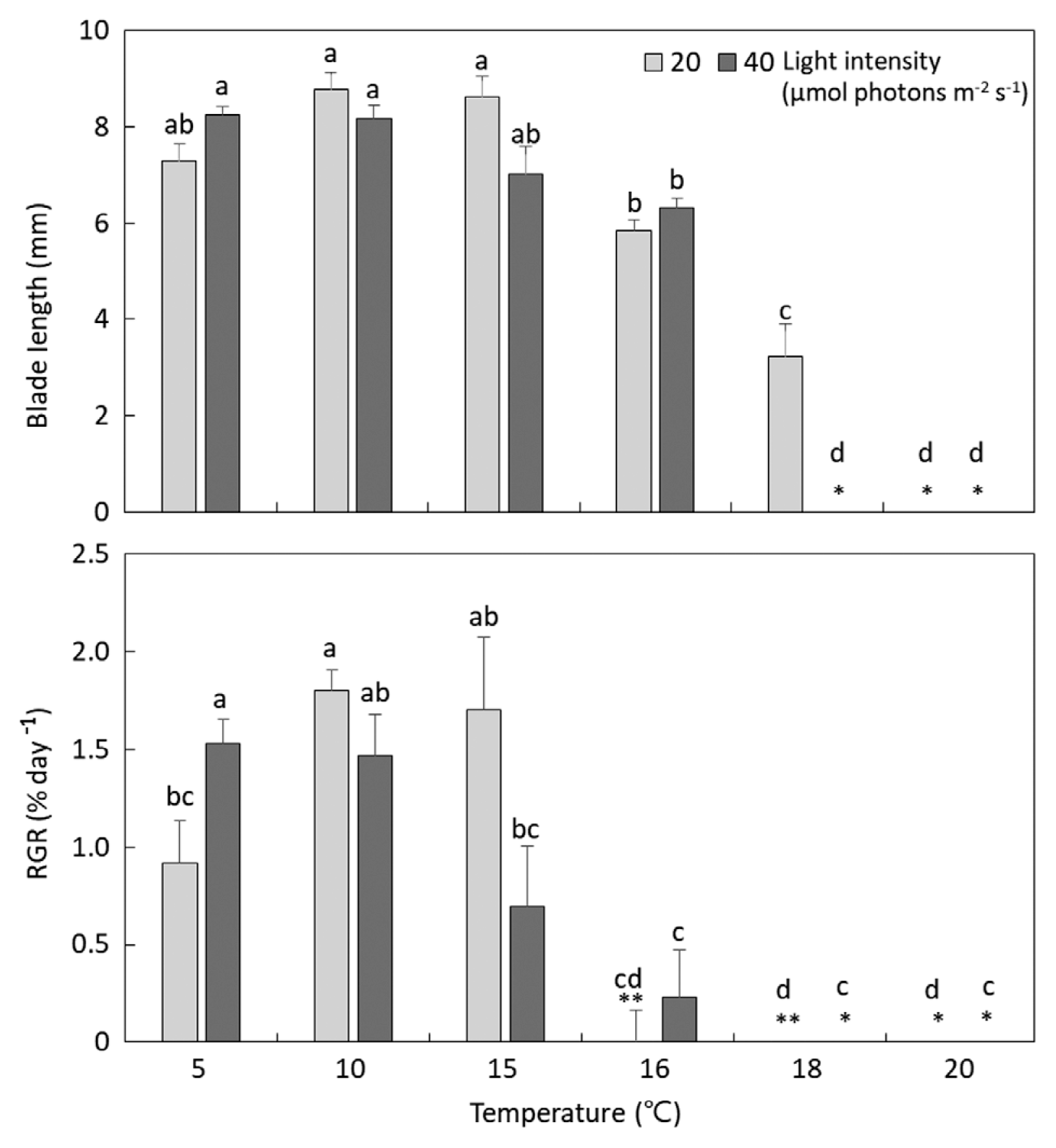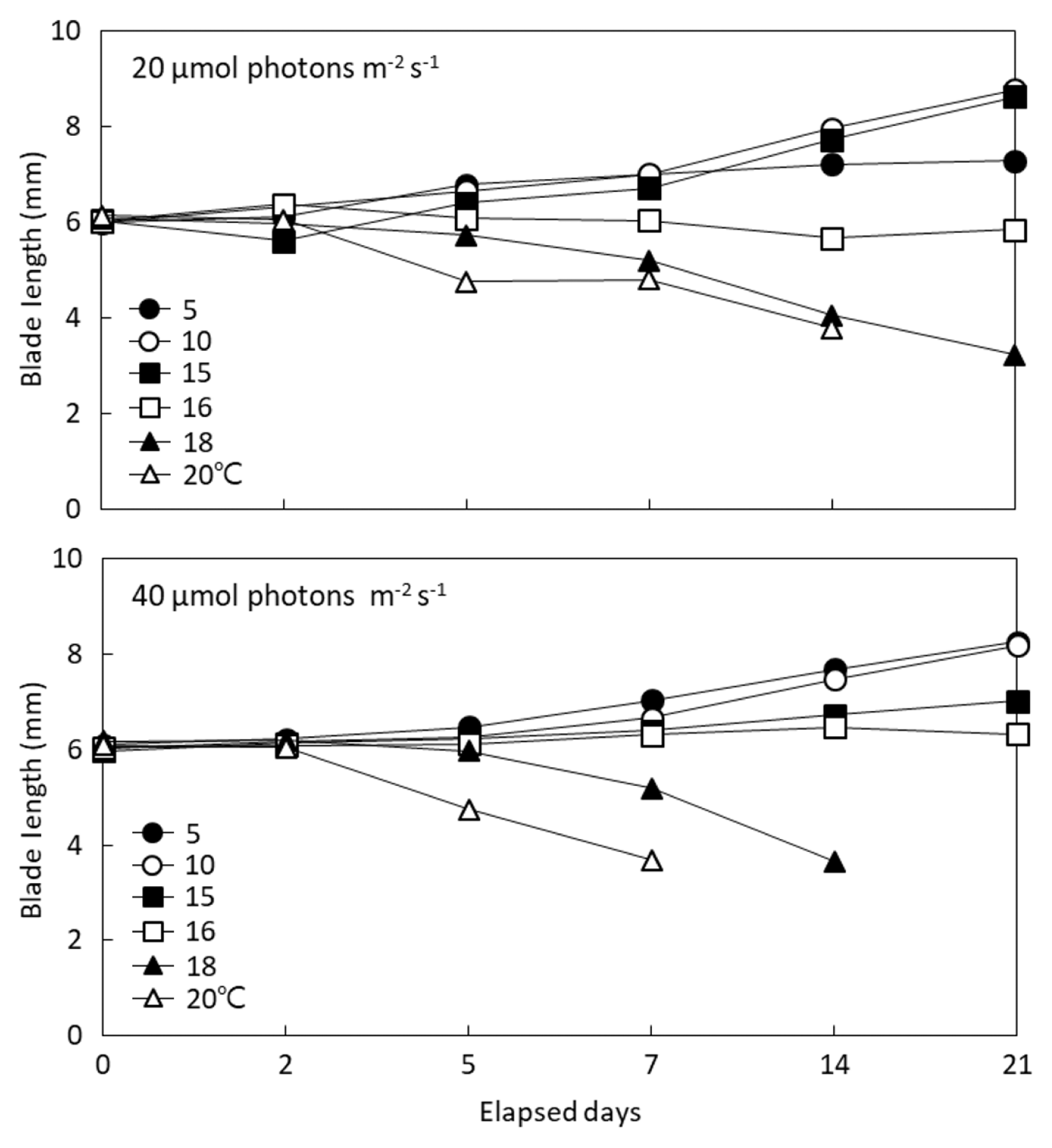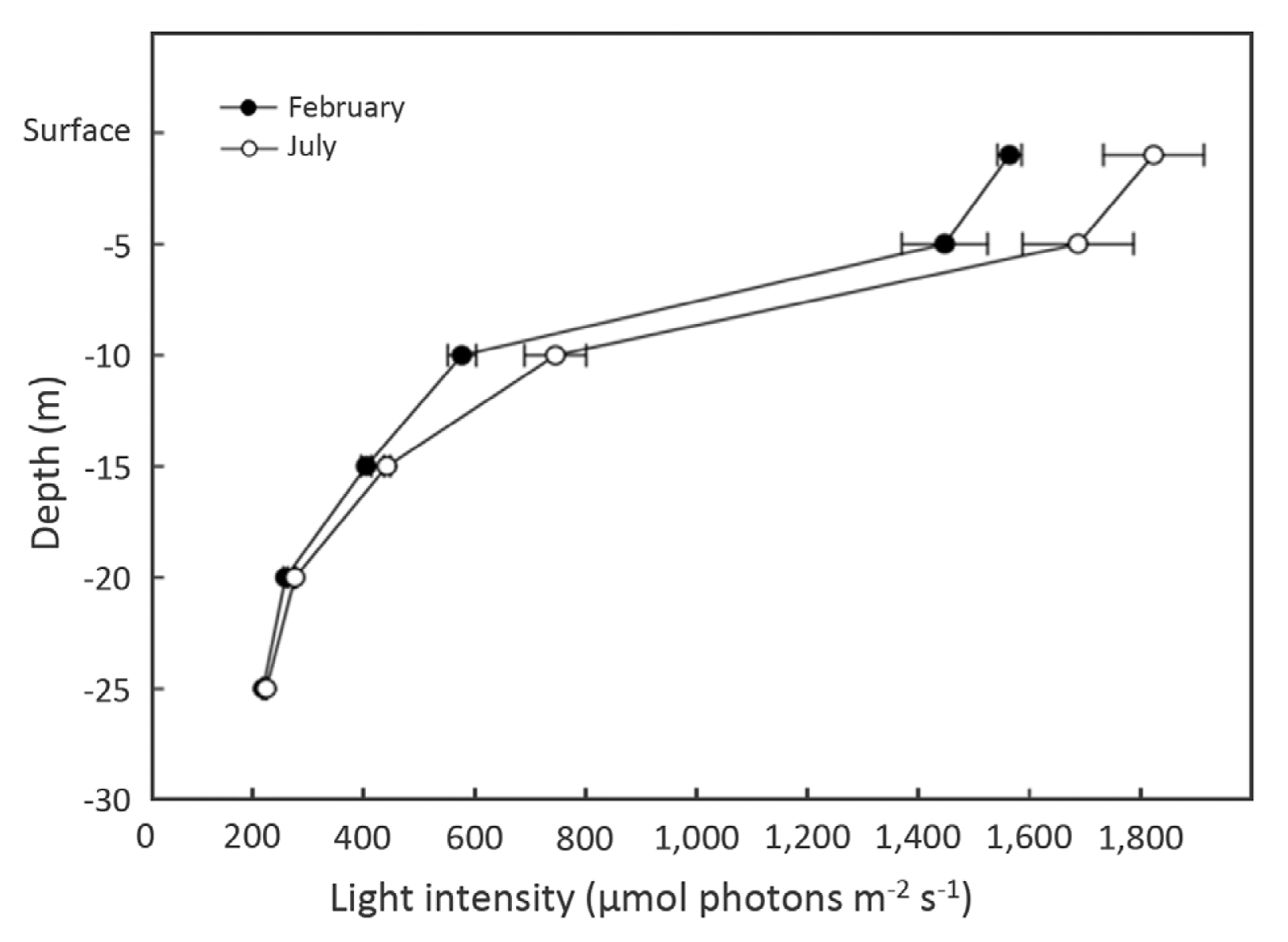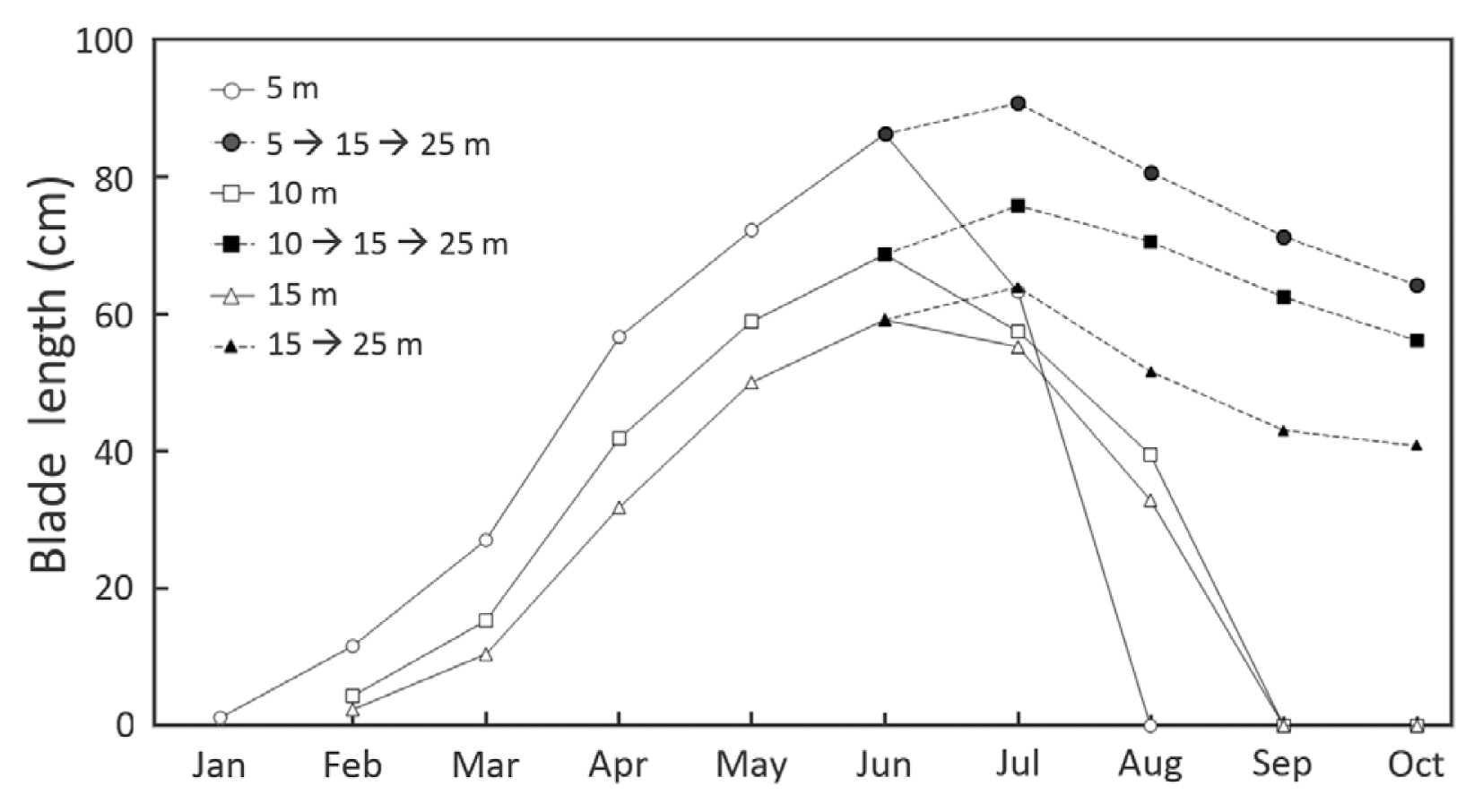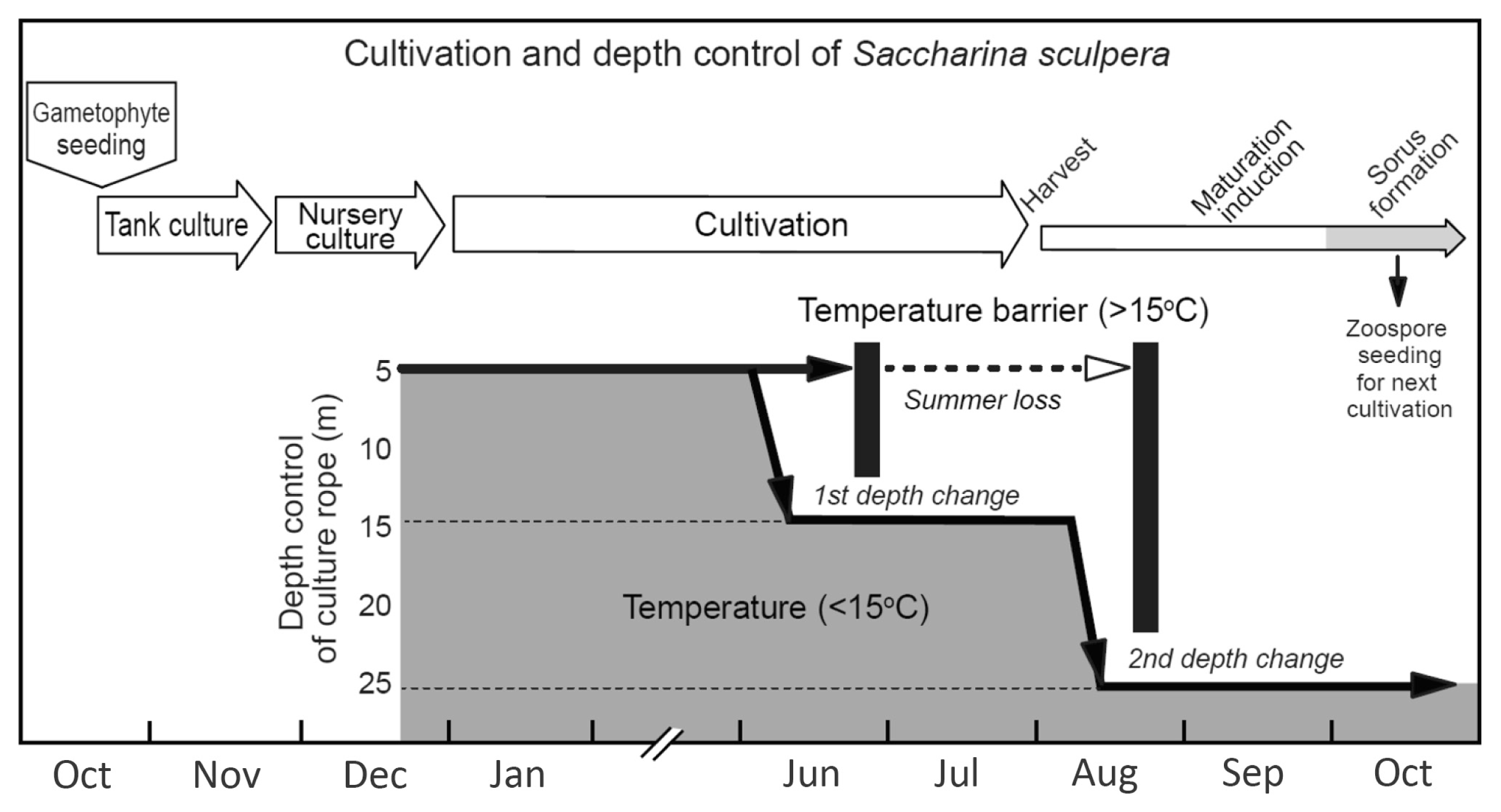INTRODUCTION
Saccharina sculpera (Miyabe), Lane, Mayes, Druehl and Saunders, is a brown alga belonging to the Order Laminariales, Class Phaeophyceae (Kang 1968, Boo et al. 2010), which is distributed in the coast of Gangneung, Gangwon Province, Korea, in Hokkaido Island, Japan, and in the southern region of Sakhalin, Russia (Lee and Kim 1999, Ozaki et al. 2001, Kim 2003, Galanin et al. 2011).
In general, brown algae are rich in water-soluble polysaccharides such as fucoidan and alginic acid. The fucoidan derived from S. sculpera exhibits more diverse biological properties than those obtained from other related species such as Costaria costata, Saccharina japonica, and Undaria pinnatifida (Qu et al. 2019, Ren et al. 2019). This alga is widely used in various industries as ingredients in functional foods, nutraceuticals, and cosmetics (Sakai and Kato 2001, 2002, Qu et al. 2019, Leandro et al. 2020). In Hakodate, Hokkaido, Japan, the production of S. sculpera has been decreasing since late 1990s due to the loss of wild S. sculpera beds caused by increased water temperatures, summer typhoons, and marine pollution (Takahashi 2000). The eastern coast of Gangwon Province, Korea, particularly Gangneung, had the largest S. sculpera population, covering over 50 ha and providing an annual production of around 1,000 tons (wet wt) in the 1990s. However, due to overexploitation of the natural resource and changes in the coastal environment, the yield declined (Kim 2003, Kim et al. 2005), and S. sculpera has not been observed in this area since 2010.
Previous studies on S. sculpera include the monthly variation in the occurrence and growth of the seaweed in the coast of Hokkaido, Japan (Yamamoto 1986), the effect of temperature and light intensity on their callus formation and tissue differentiation (Notoya and Kim 1996), uptake of nutrients (Ozaki et al. 2001), and extraction of functional bioactives (fucoidan) (Katayama et al. 2009). Recently, a study has been conducted on the phenology and morphology of natural S. sculpera populations from Hokkaido, Japan to aid with the restoration and conservation of this species (Tani et al. 2015). In Korea, research on S. sculpera have been confined to the environmental adaptation of this native kelp in the Gangwon coast (Kim 2003), identification of the optimal growth conditions of gametophytes and sporophytes through indoor culture (Kim et al. 2005), as well as the isolation and preservation of male and female gametophytes and early growth characteristics (Kim et al. 2007a, 2007b). The only previous research conducted for the purpose of aquaculture was a study on the optimal conditions for S. sculpera seedling production which utilized male and female gametophytes separated and preserved by the National Institute of Fisheries Science (Yoo et al. 2018).
The growth, maturity, and distribution of seaweeds are affected by biological and physicochemical conditions such as light, water temperature, nutrients, tides, and competition (South and Whittick 1987). Light and temperature are the primary limiting factors in the growth and maturity of algae, and they determine the horizontal and vertical distributions (Breeman 1988, Lüning 1993). These environmental factors also control the production of cultivated seaweeds (Hwang and Park 2020, Ko et al. 2020). With the declining wild populations of S. sculpera, it is necessary to develop cultivation techniques for this species. This study aimed to determine the temperature range for survival and optimum growth of juvenile S. sculpera in the laboratory, and to determine the optimal water depth and temperature combinations for growth and maturity of this species in the sea.
MATERIALS AND METHODS
Collection and culture of gametophytes
Male and female gametophytes (SRI-P00143♀, 00144♂) of S. sculpera were obtained from the Fisheries Seed and Breeding Research Institute, National Institute of Fisheries Science, Korea. The gametophyte (≥Ø 1 mm) stocks were separately placed in 200 mL beakers with 100 mL of sterilized sea water, and were fractionated into around 100 μm in size using a homogenizer (DI 25basic; GMBH & Co., Staufen, Germany). The fractionated male and female gametophytes were mixed at a ratio of 2 : 1, and were placed in a 1 L beaker with PESI medium (Tatewaki 1966) and seed strings (200 pieces, 5–6 cm long) for gametophyte fertilization and attachment (Hwang et al. 2015). Gametophyte cultures were maintained at 15°C under 40 μmol photons m−2 s−1 (14 : 10 h light : dark cycle) for 10 weeks, until the development into ≥5 mm juvenile sporophytes (Yoo et al. 2018). Culture medium was renewed every seven days.
Juvenile sporophyte growth under different light intensity and temperature
To determine the effects of temperature on the survival and growth of the juvenile S. sculpera, the juvenile sporophytes (~6 mm in size) were removed from the seed string. Five of the selected thalli were placed into a Petri dish (Ø 6 cm) with PESI culture medium (10 mL) and were cultured for 21 days under various temperatures (5, 10, 15, 16, 18, and 20°) and light intensity conditions (20 and 40 μmol photons m2 s−1). There were three replicates for each treatment, and the photoperiod during the incubation was fixed at 14 : 10 h (L : D). The National Institute of Fisheries Science (2020) reported that the juveniles died at temperatures above 20°, but the experimental temperatures for that trial had been set at 5° intervals, which limited the accuracy of identifying the critical temperature for survival of the juvenile stage. Therefore, the temperature conditions in the present study was set at 2° intervals from 16° to provide a more accurate estimate of the upper lethal temperature for juvenile sporophytes. The blade length of S. sculpera was measured 2, 5, and 7 days after the start of culture, and every 7 days thereafter. Renewal of culture medium was done every 7 days. The relative growth rate (RGR) of S. sculpera was calculated using the following equation (Serisawa et al. 2002):
, where L1 and L2 are the sporophyte blade lengths at T1 and T2 in days, respectively.
Field cultivation
The field experiments were carried out in the open waters off the Sageunjin coast of Gangneung, Gangwon Province, Korea, where natural populations of S. sculpera had grown abundantly at depths of 20–30 m (Fig. 1). The seed strings (Fig. 2A) were inserted into a Ø 3 mm transplant rope, which were then wound around the cultivation rope (Ø 40 mm) (Fig. 2B). Cultivation ropes with juveniles of S. sculpera were hanged vertically from hanging long-lines at a range of depths (5–25 m) on Dec 19, 2019 (Fig. 2C). The length of the cultivation ropes was adjusted in order to provide the desired depths (5–25 m) (Fig. 3). Five cultivation ropes were deployed at each depth treatment. The blade length and maturity of S. sculpera treatments were determined by randomly collecting 20 individuals every month from December 2019 to October 2020. Water temperature profiles were recorded during monthly growth measurements. When the water temperature rose to 16° or above, the rearing depth was adjusted to a depth (5, 10 m → 15 m in June, 15 m → 25 m in August) where the water temperature was below 16°. Culture depths were adjusted in three of the five cultivation ropes, while the initial depth was maintained in two cultivation ropes.
Monitoring of environmental parameters
The water temperature at each treatment depth was measured using a multi-parameter water quality meter (YSI proDSS; YSI Inc., Yellow Springs, OH, USA). The light intensity at each depth was measured using an LI-193SA (with LI-1400; LI-Cor, Lincoln, NE, USA) underwater quantum sensor in February and July. The probe was held at each depth for 5 min and measurements were taken 5 times at 1-min intervals and the average was calculated.
Statistical analysis
Statistical analysis of the temperature and light effects on juvenile S. sculpera was performed by a two-way ANOVA, and if there were significant differences, post-validation was conducted using the Tukey’s test method. The statistical analyses were performed using STATISTICA version 6.0 (Statsoft, Tulsa, OK, USA).
RESULTS
Growth of Saccharina sculpera juveniles at different temperatures and light intensities
Juvenile S. sculpera were cultured at different temperatures (5, 10, 15, 16, 18, and 20°) and light intensities (20 and 40 μmol photons m−2 s−1) in order to determine their optimum growth conditions. After 21 days of incubation, the maximum blade length (8.77 ± 0.36 mm, mean ± SE) was achieved at 20 μmol photons m−2 s−1 and 10°. The largest blade length at 40 μmol photons m−2 s−1 was observed at 5°. There was no significant difference in the blade length of the juvenile S. sculpera in the 5–15° range at the two light intensity conditions (Fig. 4), but the average blade length decreased at temperatures above 16°C (Fig. 5). No growth occurred at 18–20°C under 20 and 40 μmol photons m−2 s−1 (Fig. 5). This confirmed that the blade length were significantly affected by both temperature and irradiance (Table 1).
The RGR of juvenile S. sculpera after 21 days of culture at different temperatures and light intensities are shown in Fig. 4. At 20 μmol photons m−2 s−1, the growth ranged from −3.21 to 1.80% d−1 with the largest growth achieved at 10° (1.80 ± 0.11% d−1). The RGR decreased at 16° (−0.14 ± 0.31% d−1) and 18° (−3.21 ± 0.82% d−1), and no growth occurred at 20°; the seaweeds eventually died at the end of culture period. At 40 μmol photons m−2 s−1, the highest RGR was obtained at 5° (1.53 ± 0.13% d−1), the RGR decreased with rise in water temperature, with biomass loss above 16°C.
Saccharina sculpera cultivation environment measurements
The surface water temperatures measured during the monthly survey of S. sculpera were lowest at 10.6° in February, then gradually increased until they peaked at 21.6° in August and gradually dropped thereafter. No apparent thermocline was observed from December to March, with a variation in water temperature of between 0–0.4° from the surface to 25 m depth. A thermocline was observed at 15 m depth in June and 25 m depth in July and August (Table 2).
The light intensity measured during the field survey in February and July decreased sharply as the water depth increased; the light intensity measured in February was lower than that measured in July. With increasing depth the difference in light intensity reduced between the two months. The light intensity at 25 m was close to 20 μmol photons m−2 s−1 in both months (Fig. 6).
Growth and maturity of the cultured population
To determine the optimum rearing depth, S. sculpera was cultivated at a range of depths (5, 10, 15, 20, 25 m). Kelp sporophytes cultured at 5 m depth had a mean blade length of 1.1 ± 0.2 cm in January, a month after the start of rearing; they continued to grow until June when the blade length peaked at 86.3 ± 12.4 cm. The sporophytes subsequently showed a decrease in blade length (63.2 ± 14.6 cm) in July, until they disappear by the end of August (Fig. 7). As for kelp seedlings cultured at 10 and 15 m, young sporophytes were first observed in February with lengths of 4.3 ± 0.56 and 2.3 ± 0.47 cm, respectively. In June, the blade lengths peaked at 68.7 ± 15.21 and 59.1 ± 13.9 cm, respectively, and decreased thereafter until none remained in September. On one hand, the experimental groups that were lowered from 5 to 15 m, 10 to 15 m, and 15 to 25 m in June grew further in July as their blade lengths peaked at 90.8 ± 13.1, 75.8 ± 12.8, and 63.9 ± 13.7 cm, respectively. Experimental cultures that had been lowered to 15 m depth were subsequently reared at deeper depth of 25 m in August, and yet their blade lengths decreased (Fig. 7). A comparison of blade length with rearing depth in June showed that the blade lengths were 86.3 ± 12.40 cm at 5 m, 68.7 ± 15.2 cm at 10 m, and 59.1 ± 13.9 cm at 15 m, demonstrating that growth rates decreased as the culture depth increased.
S. sculpera grown at fixed depths throughout the 10-month culture period showed biomass loss beginning in July at 5-m depth, and in September at 10- and 15-m depths. The blade lengths of the experimental groups in which the rearing depth was adjusted (from 5 → 15 → 25 m; 10 → 15 → 25 m; and 15 → 25 m) were 64.2 ± 15.2, 56.1 ± 13.7, and 40.8 ± 11.4 cm, respectively in October. Mature sporophytes (indicated by presence of sori in the blades) were likewise observed in October for these experimental groups (Table 3).
DISCUSSION
The growth and maturity of algae can be affected by a variety of environmental conditions such as water temperature, light intensity, nutrients, and competition (Lüning 1990, Augyte et al. 2019), but water temperature and light intensity are considered to be the most important limiting factors (Druehl et al. 1987, Vásquez and Vega, 2001). Kain and Norton (1990) emphasize the importance of temperature, noting that the same species in different water temperatures can vary in terms of both growth rates and maturity. In this study, the juvenile Saccharina sculpera showed high growth at a low temperature (5°) and high light intensity (40 μmol photons m−2 s−1) environment, and yet also demonstrated high growth at higher water temperatures (10 to 15°) but at low light intensity (20 μmol photons m−2 s−1). Growth was suppressed under high temperature and high light intensity environment. Sato et al. (2020) reported that the minimum saturated irradiance of S. sculpera increased from 72.6 to 125.7 μmol photons m−2 s−1 when the temperature rose from 8 to 22°C, indicating that light requirements for growth vary with temperature and therefore could be considered to vary seasonally in the wild. Natural populations of S. sculpera generally occur 13 to 18 m deeper than S. japonica (Tani et al. 2015). This distribution of S. sculpera was considered to be because it has a higher affinity for low light intensity environments, and that the plant may be subject to photoinhibition at higher light intensities (Sato et al. 2020). In this study, S. sculpera showed the fastest growth at 5 m depth, where the light intensity was higher than at greater depths. This suggests that photoinhibition did not occur under the higher light intensity. It seems more likely that S. sculpera occurs mainly in deeper waters not because it is adapted to low light intensities, but because the vertical distribution is limited at shallow depths by high water temperatures in summer.
The vertical distribution of water temperature in temperate zones such as Korea is known to have seasonal variation (Sumich and Morrissey 2004). At the cultivation area used in this study, the water temperatures between 1 and 25 m were relatively stable from December to March (winter season), while a thermocline was observed at shallow depths (10 m) in June (early summer season) and at deeper depths (25 m) in August (Table 2). Jeong et al. (2013) reported that in the East Sea coast of Korea, the water temperature-depth profile is uniform in winter as seasonal winds induce vertical mixing. In summer, a thermocline starts to develop due to the warming of the sea surface, which becomes strongest in August. In autumn, the mixed layer becomes deeper due to cooling on the sea surface. These patterns align well with the vertical distribution pattern of the water temperature observed in this study.
Tani et al. (2015) reported that, for the S. sculpera population off the coast of Hakodate, Japan, the recruitment of new thalli occurs from January to June, when the average monthly water temperature ranges between 5 and 15°. Kirihara et al. (2003) and National Institute of Fisheries Science (2020) also reported that the juvenile S. sculpera in indoor culture only grew at water temperatures between 5 and 15°. However, these two studies could not draw conclusions about the critical temperature for survival of the juvenile stage as the experiments were conducted at 5° water temperature intervals. This present study identified the maximum water temperature for the survival of the juvenile S. sculpera as 16°, and normal growth occurred at temperatures below 15°.
The natural S. sculpera population in Japan mainly occurs at 13–18 m depth (Tani et al. 2015), while the population in Sageunjin coast of Gangneung, Korea occurs at 20–30 m depth (Kim et al. 2005, 2007b). Kelp population described in Tani et al. (2015) had newly recruited thalli from January to July (year 1 cohort), and their blade lengths reached around 10 cm by October without maturing (Tani et al. 2015). S. sculpera has been reported to grow up to 2 m or more in length in June-July of the following year, indicating that the commercially utilized individuals have grown for more than two years. In this study, S. sculpera showed maximum growth at 5 m depth (86.3 ± 12.4 cm in June), with declining blade length as culture depth increased. This was similar to the study by Kim et al. (2007b), which reported that the optimum water depth was 5 m for the growth of S. sculpera and the lowest growth was observed at 30m depth. However, loss of sporophyte biomass was observed at 5 m depth during summer in this study, as seawater temperatures reach 19–20°C. This suggests the negative impact of high seawater temperature on the physiological condition of the seaweed.
In order to maintain kelp cultivars below their lethal temperature in the field, the rearing depth was lowered from 5 to 15 m in June. This resulted in individuals reaching a market size of 90 cm or more in July. The Ministry of Fisheries, Korea (2007) reported that blade lengths of S. sculpera in the wild grown for more than two years were in the range of 87.5 to 132.5 cm, which was similar to the size of the first-year S. sculpera in this study.
In August, the rearing depth was further adjusted from 15 to 25 m, which resulted in the maturation of adult sporophytes in October. Azevedo et al. (2019) reported that the growth of S. latissima was fastest at 5 m depth and decreased as the water depth increased, which is consistent with the results of this study. They also inferred that the effect of high temperature at deep water would decrease due to the rapid formation of thermocline in May. Results of our study are consistent with theirs, and thereby suggest that the growth period can be extended by adjusting the culture depth according to the summer thermocline. This technique could contribute to the increase in S. sculpera production or yield, and provide a sustainable source of parental sporophytes for the mass production of seedlings (Fig. 8). The availability of mature sporophytes of S. sculpera provides opportunities for both habitat restoration and aquaculture. However, if habitat restoration is pursued without aquaculture, the large-scale harvest of the species may damage natural habitats, risking another localized extinction (Kim 2003, Kim et al. 2005). It is expected that the results of this study can be utilized to secure the sustainable supply of S. sculpera biomass through cultivation without causing damage to natural S. sculpera resources.







